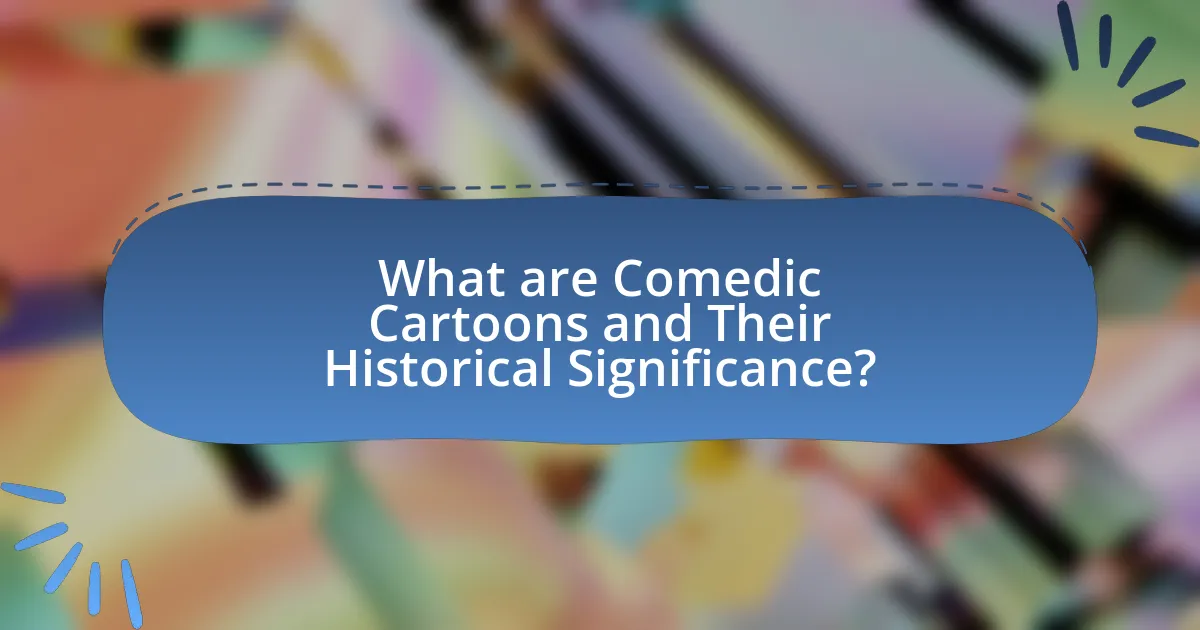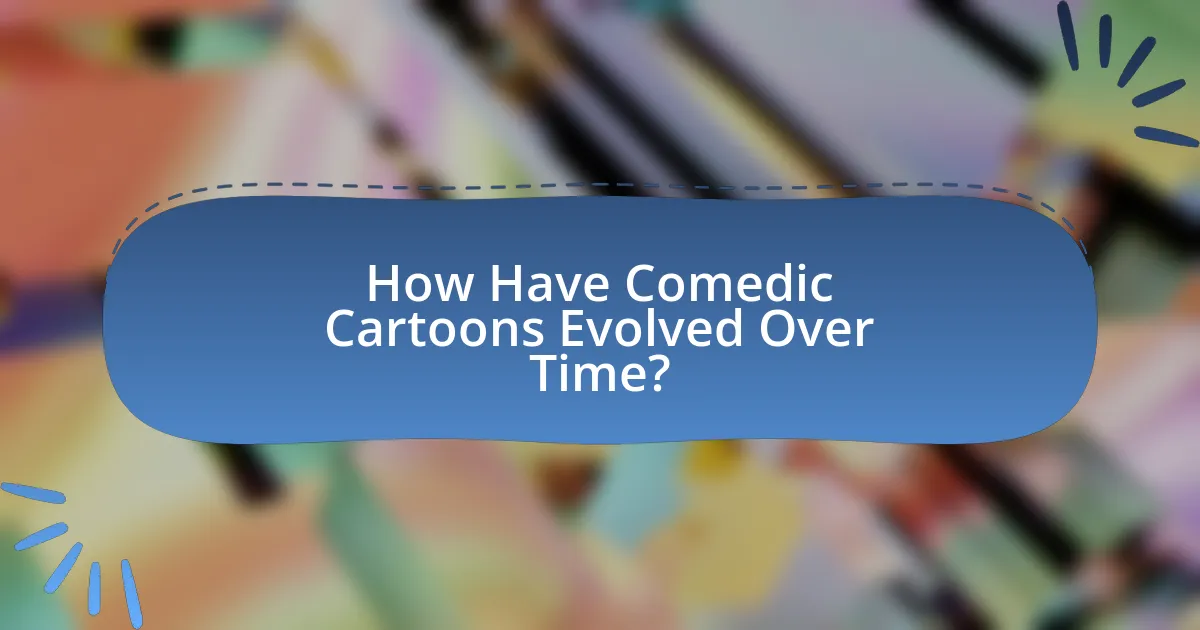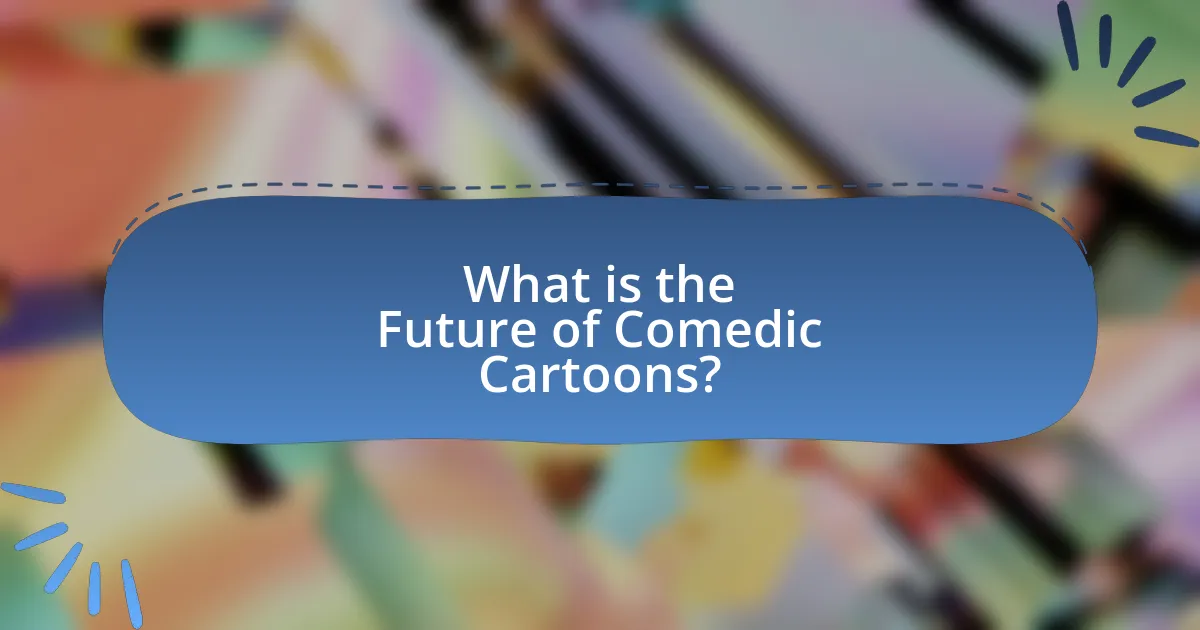The article examines the evolution of comedic cartoons, tracing their historical significance from early satirical drawings in the 18th century to contemporary animated series. It highlights the origins of comedic cartoons, their influences from vaudeville and silent films, and how societal changes have shaped their themes and humor styles. The discussion includes iconic classic cartoons, their impact on public perception of humor, and the transition from hand-drawn to digital animation. Additionally, it explores how modern cartoons address social issues with greater nuance and the future of comedic cartoons in light of technological advancements and changing audience preferences.

What are Comedic Cartoons and Their Historical Significance?
Comedic cartoons are animated or illustrated works that use humor to entertain and often critique societal norms, politics, or human behavior. Historically, they have played a significant role in shaping public opinion and reflecting cultural values, with origins tracing back to early satirical drawings in the 18th century, such as those by James Gillray in England. These cartoons evolved into various forms, including comic strips and animated series, influencing generations through platforms like newspapers and television. For instance, “The Simpsons,” which debuted in 1989, has become a cultural touchstone, showcasing the power of comedic cartoons to address complex social issues while entertaining audiences.
How did comedic cartoons originate?
Comedic cartoons originated in the late 19th century as a form of visual humor, primarily through satirical illustrations in newspapers and magazines. The advent of print technology allowed artists like Thomas Nast and George Cruikshank to create caricatures that commented on social and political issues, establishing a foundation for humor in visual storytelling. These early cartoons utilized exaggerated features and absurd situations to evoke laughter, paving the way for animated shorts in the early 20th century, such as those produced by Winsor McCay, which further popularized comedic elements in animation.
What were the early influences on comedic cartoons?
The early influences on comedic cartoons included vaudeville performances, silent films, and comic strips. Vaudeville introduced physical comedy and exaggerated expressions, which became foundational elements in animated humor. Silent films, particularly those featuring comedians like Charlie Chaplin and Buster Keaton, showcased visual gags and timing that influenced the pacing and style of early cartoons. Additionally, comic strips from newspapers, such as “Little Nemo” and “Krazy Kat,” provided a narrative structure and character development that animated shorts adopted, shaping the comedic storytelling in cartoons.
How did societal changes impact the development of comedic cartoons?
Societal changes significantly influenced the development of comedic cartoons by reflecting and satirizing contemporary issues, thereby shaping their themes and styles. For instance, during the Great Depression, cartoons often depicted economic struggles and social inequalities, using humor to provide commentary on hardship and resilience. The rise of television in the mid-20th century further transformed comedic cartoons, as they adapted to new formats and audience expectations, leading to the creation of iconic shows like “The Flintstones,” which mirrored suburban family life. Additionally, shifts in cultural attitudes, such as the civil rights movement, prompted cartoons to address social justice themes, as seen in works like “The Boondocks,” which tackled race relations and identity. These examples illustrate how societal dynamics directly impacted the content and evolution of comedic cartoons, making them a mirror of the times.
What role did classic comedic cartoons play in entertainment?
Classic comedic cartoons served as a foundational element in entertainment by shaping humor and influencing storytelling techniques. These cartoons, such as those produced by Warner Bros. and Disney, introduced innovative animation styles and comedic timing that captivated audiences, establishing a blueprint for future animated works. For instance, the slapstick humor of characters like Bugs Bunny and Mickey Mouse not only entertained but also set standards for character development and narrative pacing in animation. Their widespread popularity during the early to mid-20th century demonstrated the potential of animated media to engage diverse audiences, ultimately leading to the expansion of the animation industry and the integration of animated content into mainstream entertainment.
Which classic comedic cartoons are considered iconic?
Iconic classic comedic cartoons include “Looney Tunes,” “Tom and Jerry,” and “The Flintstones.” “Looney Tunes,” created by Warner Bros., features characters like Bugs Bunny and Daffy Duck, known for their slapstick humor and cultural impact since the 1930s. “Tom and Jerry,” produced by MGM, debuted in 1940 and is celebrated for its timeless cat-and-mouse antics, winning multiple Academy Awards. “The Flintstones,” which aired in the 1960s, is recognized as the first prime-time animated television series, blending humor with a satirical take on modern family life. These cartoons have significantly influenced the genre and remain culturally relevant today.
How did these cartoons shape public perception of humor?
Cartoons significantly shaped public perception of humor by introducing satire and social commentary into mainstream culture. Historically, cartoons like those in “The New Yorker” and political cartoons from the early 20th century used humor to critique societal norms and political figures, influencing how audiences understood and engaged with current events. For example, the satirical cartoons of Thomas Nast in the 19th century played a crucial role in shaping public opinion on issues like corruption and social justice, demonstrating that humor could be a powerful tool for social change. This evolution of comedic cartoons has established humor as a lens through which people interpret and respond to the world around them.
What are the defining characteristics of classic comedic cartoons?
Classic comedic cartoons are characterized by exaggerated physical humor, slapstick comedy, and anthropomorphic characters. These elements create a visual and comedic style that relies heavily on visual gags and absurd situations. For instance, iconic characters like Bugs Bunny and Mickey Mouse often engage in over-the-top antics that defy the laws of physics, such as characters surviving improbable accidents or using exaggerated facial expressions to convey emotions. The use of simple, bold animation styles and vibrant colors further enhances the comedic effect, making the humor accessible to a wide audience. Additionally, classic comedic cartoons often feature recurring themes of rivalry and mischief, as seen in the dynamic between characters like Tom and Jerry, which adds to the comedic tension and entertainment value.
What animation techniques were commonly used in classic cartoons?
Classic cartoons commonly utilized techniques such as hand-drawn animation, limited animation, and rotoscoping. Hand-drawn animation involved creating each frame by hand, which was the primary method used by studios like Disney and Warner Bros. Limited animation, popularized by studios like Hanna-Barbera, reduced the number of frames needed by reusing backgrounds and minimizing character movement, allowing for quicker production. Rotoscoping, a technique where animators traced over live-action footage, was used to create realistic movements, as seen in early works like Fleischer Studios’ “Out of the Inkwell.” These techniques defined the visual style and production methods of classic cartoons, contributing to their lasting impact on animation.
How did character design contribute to the humor in classic cartoons?
Character design significantly contributed to the humor in classic cartoons by exaggerating physical traits and expressions to enhance comedic effect. For instance, characters like Bugs Bunny and Daffy Duck were designed with oversized heads and expressive facial features, allowing for quick visual gags and slapstick humor. This design choice facilitated immediate recognition of emotions, making the humor more accessible and engaging for audiences. Additionally, the use of distinctive and often absurd characteristics, such as Popeye’s muscular forearms and Olive Oyl’s elongated figure, created a visual contrast that amplified comedic situations. These design elements not only defined the characters but also established a comedic language that resonated with viewers, reinforcing the humor inherent in their actions and interactions.

How Have Comedic Cartoons Evolved Over Time?
Comedic cartoons have evolved significantly over time, transitioning from simple, hand-drawn animations to complex, digitally produced series. Early comedic cartoons, such as those from the silent film era featuring characters like Felix the Cat, relied heavily on visual gags and slapstick humor due to the absence of synchronized sound. With the advent of synchronized sound in the late 1920s, cartoons like “Steamboat Willie” introduced dialogue and musical elements, enhancing comedic storytelling.
The 1940s and 1950s saw the rise of television, which brought iconic series like “Looney Tunes” and “Tom and Jerry,” characterized by their fast-paced humor and memorable characters. These cartoons often reflected societal norms and cultural references of their time. In the 1990s, the introduction of computer-generated imagery (CGI) allowed for more intricate animation styles, as seen in shows like “The Simpsons,” which combined satire with social commentary, appealing to both children and adults.
Today, comedic cartoons continue to evolve with the integration of streaming platforms, allowing for diverse storytelling and niche audiences. Series like “Rick and Morty” and “Bob’s Burgers” showcase a blend of dark humor and complex narratives, reflecting contemporary issues and appealing to a more sophisticated audience. This evolution demonstrates how comedic cartoons have adapted to technological advancements and changing cultural landscapes while maintaining their core purpose of entertainment.
What technological advancements influenced comedic cartoons?
Technological advancements such as animation techniques, sound synchronization, and digital technology have significantly influenced comedic cartoons. The introduction of cel animation in the early 20th century allowed for smoother and more expressive character movements, enhancing comedic timing. The synchronization of sound with animation, pioneered by Walt Disney in the 1928 film “Steamboat Willie,” added a new layer of humor through dialogue and sound effects. Furthermore, the advent of computer-generated imagery (CGI) in the late 20th century enabled more complex visual gags and dynamic storytelling, as seen in films like “Toy Story.” These advancements collectively transformed the comedic landscape of cartoons, making them more engaging and entertaining for audiences.
How did the transition from hand-drawn to digital animation change comedic cartoons?
The transition from hand-drawn to digital animation significantly enhanced the production quality and creative possibilities of comedic cartoons. Digital animation allows for smoother motion, more intricate designs, and faster production times compared to traditional hand-drawn methods. For instance, shows like “The Simpsons” and “Family Guy” have utilized digital techniques to create more dynamic visual gags and complex character movements, which are essential for comedic timing. Additionally, digital tools enable animators to easily edit and iterate on scenes, leading to refined comedic timing and punchlines. This shift has also expanded the range of visual styles and effects that can be employed, allowing for a broader spectrum of humor that appeals to diverse audiences.
What impact did television have on the evolution of comedic cartoons?
Television significantly transformed the evolution of comedic cartoons by providing a new platform for their widespread distribution and accessibility. The introduction of television in the mid-20th century allowed animated series like “The Flintstones” and “The Jetsons” to reach a broader audience, establishing cartoons as a staple of family entertainment. This shift led to the development of unique storytelling techniques and character designs tailored for the television format, which differed from traditional theatrical shorts. The success of these shows demonstrated the commercial viability of animated content, prompting networks to invest heavily in the production of comedic cartoons, thus shaping the genre’s direction and popularity.
How have themes and humor styles changed in contemporary comedic cartoons?
Contemporary comedic cartoons have shifted towards more diverse themes and complex humor styles, reflecting societal changes and audience expectations. Unlike classic cartoons that often relied on slapstick and straightforward humor, modern cartoons incorporate satire, social commentary, and character-driven narratives. For instance, shows like “Rick and Morty” and “BoJack Horseman” blend dark humor with existential themes, appealing to adult audiences and addressing issues such as mental health and societal norms. This evolution is supported by the rise of streaming platforms, which allow for more niche content and experimentation in storytelling, leading to a broader range of comedic styles that resonate with varied demographics.
What are the prevalent themes in modern comedic cartoons?
Prevalent themes in modern comedic cartoons include social commentary, absurdity, and character-driven humor. Social commentary often addresses contemporary issues such as politics, identity, and technology, reflecting societal concerns and engaging audiences in critical discussions. Absurdity is frequently employed to create humor through illogical scenarios and exaggerated situations, appealing to audiences’ sense of the ridiculous. Character-driven humor focuses on the quirks and relationships of well-developed characters, allowing for relatable and engaging storytelling. These themes are evident in popular shows like “Rick and Morty,” which combines social critique with absurdist elements, and “Bob’s Burgers,” which emphasizes character dynamics and family interactions.
How do contemporary comedic cartoons address social issues compared to classic ones?
Contemporary comedic cartoons address social issues with greater nuance and directness compared to classic ones. While classic cartoons often relied on slapstick humor and broad stereotypes, contemporary cartoons like “The Boondocks” and “Bob’s Burgers” tackle complex themes such as race, gender identity, and political satire, reflecting current societal debates. For instance, “The Boondocks” explicitly critiques systemic racism and cultural appropriation, using satire to provoke thought and discussion, which contrasts with classic cartoons that typically avoided controversial topics. This shift is supported by the rise of diverse creators in the animation industry, allowing for a wider range of perspectives and experiences to be represented, thus enhancing the depth and relevance of social commentary in contemporary comedic cartoons.
What are some notable contemporary comedic cartoons?
Notable contemporary comedic cartoons include “Rick and Morty,” “Bob’s Burgers,” and “The Simpsons.” “Rick and Morty,” created by Justin Roiland and Dan Harmon, is known for its dark humor and complex storytelling, gaining a significant following since its debut in 2013. “Bob’s Burgers,” created by Loren Bouchard, has been praised for its character-driven humor and family dynamics since it premiered in 2011. “The Simpsons,” which began in 1989, remains a cultural icon, influencing the genre with its satirical take on American life. These shows exemplify the evolution of comedic cartoons, blending humor with social commentary and innovative animation styles.
How do these cartoons reflect current cultural trends?
Contemporary cartoons reflect current cultural trends by addressing social issues, political satire, and diverse representation. For instance, shows like “Bob’s Burgers” and “The Boondocks” tackle themes of identity, race, and family dynamics, resonating with audiences navigating a multicultural society. Additionally, the rise of streaming platforms has allowed for more niche content that reflects specific cultural movements, such as LGBTQ+ representation in “Steven Universe.” This evolution demonstrates how cartoons adapt to and comment on societal changes, making them relevant to modern viewers.
What innovations have been introduced in storytelling within contemporary cartoons?
Contemporary cartoons have introduced innovations in storytelling such as complex character development, serialized narratives, and the incorporation of social issues. These advancements allow for deeper emotional engagement and relatability, moving beyond the simplistic plots of classic cartoons. For instance, shows like “Steven Universe” and “BoJack Horseman” utilize multi-episode arcs to explore themes of identity, mental health, and societal challenges, reflecting a shift towards more mature storytelling. This evolution is supported by audience demand for content that resonates on a personal level, as evidenced by the increasing popularity of animated series that tackle real-world issues.

What is the Future of Comedic Cartoons?
The future of comedic cartoons is likely to be shaped by advancements in technology, evolving audience preferences, and the integration of diverse storytelling methods. As streaming platforms continue to dominate media consumption, comedic cartoons will increasingly leverage animation techniques and interactive elements to engage viewers. For instance, the rise of platforms like Netflix and Hulu has already led to a resurgence in animated series, with shows such as “Big Mouth” and “Bojack Horseman” pushing boundaries in humor and narrative depth. Additionally, the incorporation of social media trends and user-generated content will further influence comedic styles, making them more relatable and timely. This evolution reflects a broader trend where comedic cartoons adapt to cultural shifts and technological innovations, ensuring their relevance in a rapidly changing entertainment landscape.
How might comedic cartoons continue to evolve in the coming years?
Comedic cartoons are likely to evolve by integrating advanced technology, such as artificial intelligence and augmented reality, to enhance storytelling and viewer engagement. As audiences increasingly seek personalized content, creators may utilize data analytics to tailor humor and themes to specific demographics, ensuring relevance and resonance. Additionally, the rise of streaming platforms has shifted the landscape, allowing for more diverse and experimental formats, which can lead to innovative comedic styles and narratives. Historical trends indicate that as societal norms and values change, comedic cartoons will adapt to reflect contemporary issues, ensuring they remain a relevant form of entertainment.
What emerging technologies could influence the production of comedic cartoons?
Emerging technologies such as artificial intelligence, virtual reality, and advanced animation software could significantly influence the production of comedic cartoons. Artificial intelligence can automate aspects of animation, allowing for quicker production times and more dynamic character interactions, as seen in projects like “The Simpsons” using AI for script generation. Virtual reality offers immersive storytelling experiences, enabling audiences to engage with comedic content in new ways, exemplified by VR experiences that allow users to interact with cartoon environments. Advanced animation software, like Blender and Toon Boom Harmony, enhances the creative process by providing tools for more intricate designs and fluid animations, which can elevate the comedic impact of the cartoons.
How might audience preferences shape the future of comedic cartoons?
Audience preferences will significantly shape the future of comedic cartoons by driving content creators to adapt themes, humor styles, and character representations that resonate with contemporary viewers. As audiences increasingly seek diverse and inclusive narratives, creators are likely to incorporate varied cultural perspectives and social issues into comedic storytelling. For instance, the rise of streaming platforms has led to a demand for more niche content, allowing for experimentation with unconventional humor and formats, as seen in shows like “Big Mouth” and “Tuca & Bertie.” This shift reflects a broader trend where audience feedback, through social media and viewership analytics, directly influences the direction of comedic content, ensuring that future cartoons align with evolving societal values and preferences.
What lessons can creators learn from the evolution of comedic cartoons?
Creators can learn the importance of adaptability and audience engagement from the evolution of comedic cartoons. Historically, comedic cartoons have shifted in style and content to reflect societal changes and audience preferences, as seen in the transition from the slapstick humor of early animations like “Looney Tunes” to the more nuanced satire found in contemporary shows like “The Simpsons.” This evolution demonstrates that successful creators must be responsive to cultural contexts and audience feedback, ensuring their work remains relevant and relatable. Additionally, the incorporation of diverse storytelling techniques and character development in modern cartoons highlights the necessity for creators to innovate and expand their narrative approaches to maintain viewer interest and connection.
How can understanding past trends inform future comedic cartoon creation?
Understanding past trends in comedic cartoons can significantly inform future creation by highlighting successful themes, styles, and audience preferences. Historical analysis reveals that cartoons like “Looney Tunes” and “The Simpsons” effectively utilized satire and cultural references, which resonated with viewers and shaped comedic expectations. For instance, the rise of political satire in the 1990s, exemplified by “The Simpsons,” demonstrated how current events could be woven into humor, influencing subsequent creators to adopt similar approaches. Additionally, trends such as the shift from slapstick to character-driven humor reflect changing audience tastes, guiding future cartoonists in crafting relatable and engaging content. By studying these patterns, creators can better align their work with audience interests, ensuring relevance and appeal in a competitive landscape.
What best practices should new creators consider when developing comedic cartoons?
New creators should prioritize originality and character development when developing comedic cartoons. Originality ensures that the content stands out in a saturated market, while strong character development allows for relatable and engaging storytelling. According to a study by the University of Southern California, well-developed characters can enhance audience connection and retention, leading to greater success in comedic storytelling. Additionally, creators should focus on timing and pacing, as comedic delivery relies heavily on these elements to maximize humor impact.


